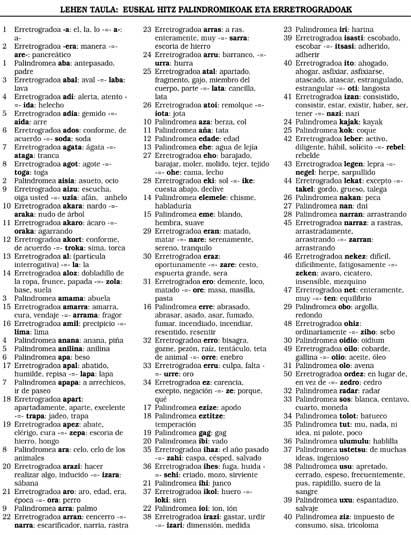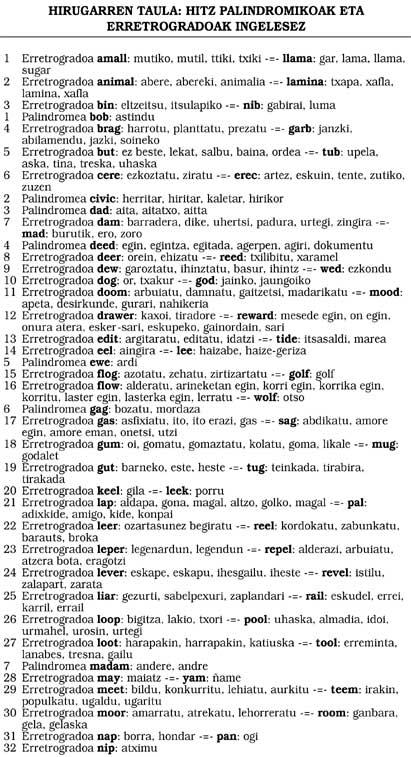Basque palindromes, the hidden wealth of Basque or Aupa!, Epi, the corrupt eye of fat
What is it?
Palindromo is a capicua word or expression. When we read both normally and vice versa, it is the same or the same. In Basque, for example USTETSU or AISIALDIA, and in Spanish RECOGNIZE or ANILINA. Etymologically, the term palindromo comes from palines and roots . These mean running again, respectively. To complete it, we can associate what we call retrograde to these specific palindromes (i.e., etymologically inverse). These words, the retrogrades, although read backwards, are sensible expressions in the same language, although the meanings are different. In Basque, for example, ARAZ and IZARA, or in Spanish AZAR and RAZA.
Cause

After saying what they are, it is clear that palindromes are for lovers of word games. Although the reasons governing the search for palindromes are deep, they are based on a friendly aesthetic that generates any symmetry. Nature and its laws have many symmetric properties and many physical magnitudes are reversible.
Palindric words are homologous in other fields: melodies that can be advanced from behind, capicated numbers, drawings with axial symmetry...
Within modern psychoanalysis, Karl Jung speaks of conflicts based on the binomials of words, such as God-Dog (Jainko-Txakur).
Examples
Basque lexicography has an extraordinary richness of palindromes and retrograde words, superior to that of other languages (Spanish and English), as shown in this short comparative research. Finally, as an annex, we show three lists of palindromes and retrogrates. For the elaboration of these tables dictionaries and a computer program have been used.
Some words that appear in the lists are in three languages. The RADAR, for example, is an anglicism as a palindromo, performed as such, to express the reflection of radio waves.
In Borgmann's literary work a large number of palinodric words appear in several languages (unfortunately, he has not introduced the Basque language). The longest palindromo is saippuakauppias, which in suomí means soap dish. Among the names of palindromes toponyms is Wassamassaw, a village located in North Carolina. It means the worst place ever seen in the Indian language. Proper names include: Lon Nol, former minister of Burma, and Revilo P. Oliver, professor at the University of Illinois.
The tournaments for the creation of palindromes have had very good consequences in the most elaborate languages. In palindromic prayer the articulation is especially rewarded. The length of the sentence is of great importance, as well as the facilities of understanding and spontaneity. In Spanish, phrases such as dábale arroz a la deuda el abad, Anita lava la tina, or Anás used your car, Susana . The latter belongs to the famous writer Julio Kortazar.
In English, a contest awarded: Doc, note, I dissent. A fast never prevents fatness. I diet on cod (Look, agure, I disagree. Fasting does not preserve it from obesity. I have a cod diet). The following sentence is the work of a famous Anglo-Saxon palindromist: A man, a plan, a canal-Panama! (A man, a plan, a Panama canal). Another English formed a palindromic proverb to adequately answer the character Ned's question: Named undenominationally rebel, I rile Beryl? No! In I. I’m, O Ned, nude, man! (Irreverent rebel me? Provocation Beryl? Ned, boy, I'm naked to be brown! ).
Some proposals
As a last suggestion, we want to encourage readers to make new palindric expressions or phrases themselves. The following tables can be used for this purpose. That will love crossword lovers. Better yet, it is an insurmountable remedy against insomnia.
If we were more daring, we would call the championship of palindromes. This would encourage the creation of palindromes, as has happened in other languages. The year 1991, unique to the palindromo of this century, would be a good date to start.
Before we finish, we must recognize that we have not had time to investigate the Basque names and toponomics in search of the palindromo. As models we will mention: Ana, Iruri, Isasi, Oro,..., in proper names: Aia, Amara and Arama, Aiara and Araia, Araka and Akara,..., in the toponymics. This suggests that good results can be achieved.
At the moment we do not have the necessary lexicographic and linguistic qualifications. Therefore, we cannot give precise explanations about the abundance of palindromes in Basque. Perhaps it is due to the great use of some letters in relation to the compactness of many Basque words. This article has no effect. Our intention was to present some reflections on this anecdote of Basque.
The subtitle that appears in the heading of this text aims to make a small contribution to the Basque palindromes. We would be happy to enrich this marginalized section of Basque with another more useful contribution. Even if it looks like an empty and silly job, it can also be nice.
Congratulations and happy year 1991 palm tree!


Note: To see the tables go to pdf.
Buletina
Bidali zure helbide elektronikoa eta jaso asteroko buletina zure sarrera-ontzian











